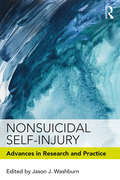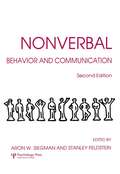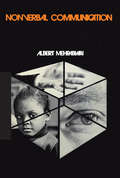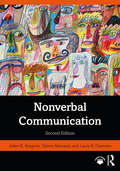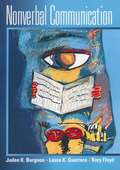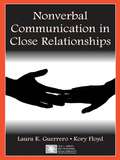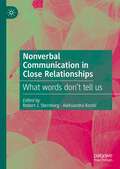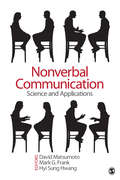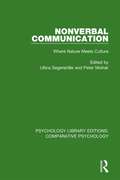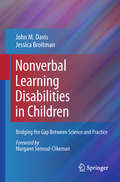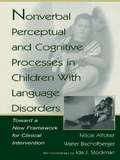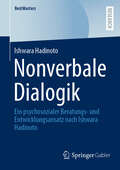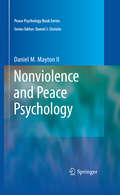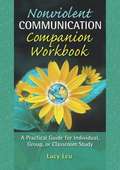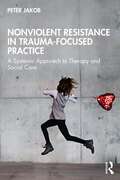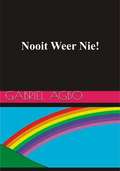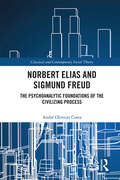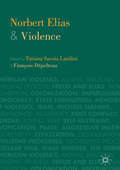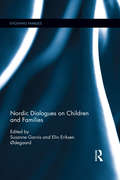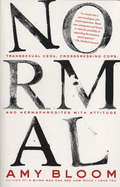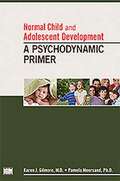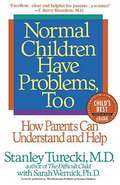- Table View
- List View
Nonsuicidal Self-Injury: Advances in Research and Practice
by Jason J. WashburnNonsuicidal Self-Injury moves beyond the basics to tackle the clinical and conceptual complexity of NSSI, with an emphasis on recent advances in both science and practice. Directed towards clinicians, researchers, and others wishing to advance their understanding of NSSI, this volume reviews and synthesizes recent empirical findings that clarify NSSI as a theoretical and clinical condition, as well as the latest efforts to assess, treat, and prevent NSSI. With expertly written chapters by leaders in the field, this is an essential guide to a disorder about which much is still to be known.
Nonverbal Behavior and Communication
by Aron W. Siegman Stanley FeldsteinFirst published in 1987. Routledge is an imprint of Taylor & Francis, an informa company.
Nonverbal Communication
by Albert MehrabianEven though our society subtly discourages the verbal expression of emotions, most of us, in ostensibly conforming to our roles, nevertheless manage to express likes, dislikes, status differences, personalities, as well as weaknesses in nonverbal ways. Using vocal expressions; gestures, postures, and movements, we amplify, restrict, or deny what our words say to one another, and even say some things with greater facility and efficiency than with words.In this new, multidimensional approach to the subject of nonverbal communication Albert Mehrabian brings together a great deal of original work which includes descriptions of new experimental methods that are especially suited to this field, detailed findings of studies scattered throughout the literature, and most importantly, the integration of these findings within a compact framework.The framework starts with the analysis of the meanings of various nonverbal behaviors and is based on the fact that more than half of the variance in the significance of nonverbal signals can be described in terms of the three orthogonal dimensions of positiveness, potency or status, and responsiveness. These three dimensions not only constitute the semantic space for nonverbal communication, but also help to identify groups of behaviors relating to each, to describe characteristic differences in nonverbal communication, to analyze and generate rules for the understanding of inconsistent messages, and to provide researchers with new and comprehensive measures for description of social behavior.This volume will be particularly valuable for both the professional psychologist and the graduate student in psychology. It will also be of great interest to professionals in the fields of speech and communication, sociology, anthropology, and psychiatry.
Nonverbal Communication
by Laura K. Guerrero Judee K Burgoon Valerie ManusovThe newly revised edition of this groundbreaking textbook provides a comprehensive overview of the theory, research, and applications of nonverbal communication. Authored by three of the foremost scholars in the field and drawing on multidisciplinary research from communication studies, psychology, linguistics, and family studies, Nonverbal Communication speaks to today’s students with modern examples that illustrate nonverbal communication in their lived experiences. It emphasizes nonverbal codes as well as the functions they perform to help students see how nonverbal cues work with one another and with the verbal system through which we create and understand messages and shows how consequential nonverbal means of communicating are in people’s lives. Chapters cover the social and biological foundations of nonverbal communication as well as the expression of emotions, interpersonal conversation, deception, power, and influence. This edition includes new content on “Influencing Others,” as well as a revised chapter on “Displaying Identities, Managing Images, and Forming Impressions” that combines identity, impression management, and person perception. Nonverbal Communication serves as a core textbook for undergraduate and graduate courses in communication and psychology. Online resources for instructors, including an extensive instructor’s manual with sample exercises and a test bank, are available at www.routledge.com/9780367557386
Nonverbal Communication
by Laura K. Guerrero Kory Floyd Judee K. BurgoonThis new edition, authored by three of the foremost scholars in nonverbal communication, builds on the approach pioneered by Burgoon, Buller and Woodall which focused on both the features and the functions that comprise the nonverbal signaling system. Grounded in the latest multidisciplinary research and theory, Nonverbal Communication strives to remain very practical, providing both information and application to aid in comprehension.
Nonverbal Communication in Close Relationships
by Laura K. Guerrero Kory FloydNonverbal Communication in Close Relationships provides a synthesis of research on nonverbal communication as it applies to interpersonal interaction, focusing on the close relationships of friends, family, and romantic partners. Authors Laura K. Guerrero and Kory Floyd support the premise that nonverbal communication is a product of biology, social learning, and relational context. They overview six prominent nonverbal theories and show how each is related to bio-evolutionary or sociocultural perspectives. Their work focuses on various functions of nonverbal communication, emphasizing those that are most relevant to the initiation, maintenance, and dissolution of close relationships. Throughout the book, Guerrero and Floyd highlight areas where research is either contradictory or inconclusive, hoping that in the years to come scholars will have a clearer understanding of these issues. The volume concludes with a discussion of practical implications that emerge from the scholarly literature on nonverbal communication in relationships – an essential component for understanding relationships in the real world. Nonverbal Communication in Close Relationships makes an important contribution to the development of our understanding not only of relationship processes but also of the specific workings of nonverbal communication. It will serve as a springboard for asking new questions and advancing new theories about nonverbal communication. It is intended for scholars and advanced students in personal relationship study, social psychology, interpersonal communication, nonverbal communication, family studies, and family communication. It will also be a helpful resource for researchers, clinicians, and couples searching for a better understanding of the complicated roles that nonverbal cues play in relationships.
Nonverbal Communication in Close Relationships: What words don’t tell us
by Robert J. Sternberg Aleksandra KostićThis book is an up-to-date compendium of knowledge on the secret language of close relationships, namely nonverbal routes of communication. In close relationships, as everyone learns sooner or later, the usefulness of words can be somewhat limited, because people (a) mean different things by the same words, (b) mean the same thing by different words, (c) sometimes find it hard to express their feelings in words, and (d) lie. Nonverbal signals therefore often provide the best means of communication. The book points out how decoding (interpreting) nonverbal signals is a major key to success, because often what people say wholly belies how they feel—nonverbal signals reveal their true feelings rather than what they want other people to think their feelings are. This book helps decode those secret signals. The book is written by the leading worldwide experts in the field of nonverbal communication to ensure accuracy, comprehensiveness, and timeliness.
Nonverbal Communication: Science and Applications
by David Matsumoto Dr Mark G. Frank Hyi Sung HwangEdited by three leading authorities on nonverbal behavior, this book examines state-of-the-art research and knowledge regarding nonverbal behavior and applies that scientific knowledge to a broad range of fields. The editors present a true scientist-practitioner model, blending cutting-edge behavioral science with real-world practical experience—the first of its kind to merge theoretical and practical worlds. The observations of the practitioners who share their insights and experience will inspire and generate many new research ideas. This book is a valuable resource for students, practitioners and professionals to discover the science behind the practice and to see how other professionals have incorporated nonverbal communication into practice.
Nonverbal Communication: Where Nature Meets Culture (Psychology Library Editions: Comparative Psychology)
by Ullica Segerstråle Peter MolnárThe field of nonverbal communication is a strategic site for demonstrating the inextricable interrelationship between nature and culture in human behaviour. This book, originally published in 1997, aims to explode the misconception that "biology" is something that automatically precludes or excludes "culture". Instead, it points to the necessary grounding of our social and cultural capabilities in biological givens and elucidates how biological factors are systematically co-opted for cultural purposes. The book presents a complex picture of human communicative ability as simultaneously biologically and socioculturally influenced, with some capacities apparently more biologically hard-wired than others: face recognition, imitation, emotional communication, and the capacity for language. It also suggests that the dividing line between nonverbal and linguistic communication is becoming much less clear-cut. The contributing authors are leading researchers in a variety of fields, writing here for a general audience. The book is divided into sections dealing with, respectively, human universals, evolutionary and developmental aspects of nonverbal behaviour within a sociocultural context, and finally, the multifaceted relationships between nonverbal communication and culture.
Nonverbal Learning Disabilities in Children
by John M. Davis Jessica BroitmanThis book offers a well-rounded understanding of nonverbal learning disabilities (NVLD) in children, placing it within the context of other developmental disorders, most notably high-functioning autism and Asperger's syndrome.
Nonverbal Perceptual and Cognitive Processes in Children With Language Disorders: Toward A New Framework for Clinical intervention
by Walter Bischofberger F‚licie AffolterA growing body of literature is suggesting that many children with language disorders and delays--even those with so-called specific language impairment--have difficulties in other domains as well. In this pathbreaking book, the authors draw on more than 40 years of research and clinical observations of populations ranging from various groups of children to adults with brain damage to construct a comprehensive model for the development of the interrelated skills involved in language performance, and trace the crucial implications of this model for intervention. Early tactual feedback, they argue, is more critical for the perceptual/cognitive organization of experiences that constitutes a foundation for language development than either visual or auditory input, and the importance of tactually-anchored nonverbal interaction cannot be ignored if efforts at treatment are to be successful. All those professionally involved in work with children and adults with language problems will find the authors' model provocative and useful.
Nonverbale Dialogik: Ein psychosozialer Beratungs- und Entwicklungsansatz nach Ishwara Hadinoto (BestMasters)
by Ishwara HadinotoZentral für viele Organisationen und ihre Mitglieder ist das „Doppelbindungsdilemma“; es manifestiert sich in einem tiefgreifenden Kommunikationsproblem: Oftmals übermitteln die Betroffenen durch subtile nonverbale Signale ihre Vorwürfe, trauen sich jedoch nicht, das eigentliche Problem offen anzusprechen. Sie fürchten negative Reaktionen oder Sanktionen. Diese Dynamik kann für Organisationen weitreichende Auswirkungen haben. Hier kommt Ishwara Hadinoto’s Konzept der „Nonverbalen Dialogik“ ins Spiel. Diese Arbeit betrachtet verschiedene Dimensionen des Selbstwerts. Von großer Bedeutung ist dabei die zentrale Rolle nonverbaler Kommunikation und von Doppelbindungen als ursächliche Stressfaktoren. Nach einer Analyse zur Konfliktlösung wird dargelegt, wie die Nonverbale Dialogik Psychoanalyse, Humanistische Psychologie und daoistische Philosophie in einem innovativen Ansatz verbindet. Schließlich wird das Augenmerk auf die direkte Anwendung der Methode und ihre messbaren Auswirkungen auf Coachees gerichtet.
Nonviolence and Peace Psychology
by Daniel MaytonRecent trends and events worldwide have increased public interest in nonviolence, pacifism, and peace psychology as well as professional interest across the social sciences. Nonviolence and Peace Psychology assembles multiple perspectives to create a more comprehensive and nuanced understanding of the concepts and phenomena of nonviolence than is usually seen on the subject. Through this diverse literature--spanning psychology, political science, religious studies, anthropology, and sociology--peace psychologist Dan Mayton gives readers the opportunity to view nonviolence as a body of principles, a system of pragmatics, and a strategy for social change. This important volume: Draws critical distinctions between nonviolence, pacifism, and related concepts. Classifies nonviolence in terms of its scope (intrapersonal, interpersonal, societal, global) and pacifism according to political and situational dimensions. Applies standard psychological concepts such as beliefs, motives, dispositions, and values to define nonviolent actions and behaviors. Brings sociohistorical and cross-cultural context to peace psychology. Analyzes a century's worth of nonviolent social action, from the pathbreaking work of Gandhi and King to the Courage to Refuse movement within the Israeli armed forces. Reviews methodological and measurement issues in nonviolence research, and suggests areas for future study. Although more attention is traditionally devoted to violence and aggression within the social sciences, Nonviolence and Peace Psychology reveals a robust knowledge base and a framework for peacebuilding work, granting peace psychologists, activists, and mediators new possibilities for the transformative power of nonviolence.
Nonviolent Communication Companion Workbook
by Lucy LeuThis companion workbook to 'Nonviolent Communication' provides reviews, activities, and brief assignments that complement the liberating principles of utilising nonviolent communication in everyday life. Support for group practice includes guidance for getting started, curriculum and activities for each chapter, and strategies for incorporating into the learning process many of the challenges that commonly arise in group situations. Additionally, teachers can use the material as the basis for developing courses or to augment an existing curriculum. Extensive reference and resource sections allow further research and follow-up study.
Nonviolent Communication: A Language of Life
by Marshall B. Rosenberg Arun GandhiDo you hunger for skills to improve the quality of your relationships, to deepen your sense of personal empowerment or to simply communicate more effectively? Unfortunately, for centuries our culture has taught us to think and speak in ways that can actually perpetuate conflict, internal pain and even violence. Nonviolent Communication partners practical skills with a powerful consciousness and vocabulary to help you get what you want peacefully. <P><P>In this internationally acclaimed text, Marshall Rosenberg offers insightful stories, anecdotes, practical exercises and role-plays that will dramatically change your approach to communication for the better. Discover how the language you use can strengthen your relationships, build trust, prevent conflicts and heal pain. Revolutionary, yet simple, NVC offers you the most effective tools to reduce violence and create peace in your life--one interaction at a time.
Nonviolent Communication: A Language of Life
by Marshall B. RosenbergAn enlightening look at how peaceful communication can create compassionate connections with family, friends, and other acquaintances. The book uses stories, examples, and sample dialogues to provide solutions to communication problems both at home and in the workplace. Guidance is provided on identifying and articulating feelings and needs, expressing anger fully, and exploring the power of empathy in order to speak honestly without creating hostility, break patterns of thinking that lead to anger and depression, and communicate compassionately. These non-violent communication skills are fully explained and can be applied to personal, professional, and political differences. Included in this new edition is information on how to compassionately connect with oneself.
Nonviolent Communication™: A Language of Life
by Marshall B. RosenbergNonviolent Communication skills are partnered with a powerful Consciousness, Language, Communication and Means of influence. Nonviolent Communication serves our desire by Increase our ability to live with choice, meaning, and connection. Connect empathically with self and others to have more satisfying relationships. Sharing of resources so everyone is able to benefit.
Nonviolent Resistance in Trauma-Focused Practice: A Systemic Approach to Therapy and Social Care
by Peter JakobThis book presents Nonviolent Resistance (NVR) for trauma‑focused care, adopting a systemic and trauma‑orientated approach to aggressive and self‑destructive behaviours in young people. Based on systemic therapy methods and principles in socio‑political NVR, NVR targets aggressive and self‑destructive child behaviours in a relational way to help parents develop self‑efficacy in responding to the problematic behaviour and grow a supportive community around the family. In this book, Peter Jakob integrates the original NVR model with aspects of trauma and attachment theory, solution‑focused therapy and narrative therapy, in order to expand the efficacy of NVR in trauma‑focused work. Grounded in Jakob’s extensive clinical experience and research, the book will help the reader navigate the complexity of working across various systems in family therapy and counselling, particularly within challenging contexts such as multi‑stressed families, adoptive families, foster‑ and residential care. Method descriptions and illustrative case examples are featured throughout the chapters to ultimately help readers contribute to their clients’ (re)discovery of their internal and interpersonal resources and ultimately promote healing from trauma for everyone involved. This text is an essential resource for a wide variety of mental health professionals, social workers and family workers, as well as caregivers and managers in residential care.
Nooit Weer Nie!
by Gabriël Agbo"Die Here sê: “Ek sal herstel wat julle deur die stropersprinkane, die snysprinkane, die swermsprinkane en die jong sprinkane verloor het. Ek het hierdie groot, vernietigende leër teen julle gestuur. “Julle sal weer al die kos kry wat julle begeer. Julle sal die Here julle God loof wat hierdie wonders vir julle moontlik maak. My volk sal nooit weer so in die skande kom nie. Julle sal weet dat Ek onder my volk Israel teenwoordig is. Net Ek is die Here julle God, niemand anders nie! My volk sal nooit weer so in die skande kom nie.” Joël 2: 25-27 Dit is tyd om die dinge wat jou wil stop, te stop, Dit is God se wil om alles te stop wat jou van Sy plan vir jou lewe wil verwyder. En jy weet alreeds dat Sy plan vir jou is om die beste van vreugde, vrede, voorspoed, genade, goeie gesondheid en om al jou eiendom te besit. Selfs as jy onder oordeel staan, kan dit omgedraai word vandag en jy kan weer begin om in Sy genade te swem. Ons kyk ook na ander se ondervindings en die moderne Israel se weergawe van Nooit Weer nie. Hoekom hulle hierdie slagspreuk aangeneem het en hoe vêr hulle gekom het om dit toe te pas? Sekerlik, Israel het vandag een van die mees magtigste nasies op aarde geword, (Dit het die beste intelligensie agentskap, Mossad en die derde beste weermag in die wêreld) nie net omdat God met hulle is nie, maar omdat hulle belowe het om nooit weer toe te laat dat die Jode weer deur daardie mees onmenslik, vermybare gebeurtenis van die laaste eeu. Vandag lei hulle nie net in verdediging nie maar ook in landbou, ICT, wetenskap en medisyne. Ja, ons kan vandag sê nooit weer nie. Hierdie boek is verseker 'n interessante lees.
Norbert Elias and Sigmund Freud: The Psychoanalytic Foundations of the Civilizing Process (Classical and Contemporary Social Theory)
by André Oliveira CostaThis book explores the influence of Freudian psychoanalysis on Norbert Elias’ theory of the civilizing process – an influence acknowledged by Elias himself – conducting a dialogue with a view to analyzing points of contact and distance between them. Examining the development of Elias’ work, it sheds light on the integration of psychoanalytic concepts in his thought, considering the dynamics that exist between individuals and social processes, as the civilizing process affects the psychic economy of individuals and psychic structures serve to sustain civilization. A genealogical study of Freudian concepts as expressed in the trajectory of Elias’s sociology, it will appeal to scholars of sociology and psychology with interests in social and psychoanalytic theory.
Norbert Elias and Violence
by Tatiana Savoia Landini François DépelteauThis book presents key conceptualizations of violence as developed by Norbert Elias. The authors explain and exemplify these concepts by analyzing Elias's late texts, comparing his views to those of Sigmund Freud, and by analyzing the work of filmmaker Michael Haneke. The authors then discuss the strengths and shortcomings of Elias's thoughts on violence by examining various social processes such as colonization, imperialism, and the Brazilian civilizing process--in addition to the ambivalence of state violence. The final chapters suggest how these concepts can be used to explain difficulties in implementing democracy, grappling with memories of violence, and state building after democracy.
Nordic Dialogues on Children and Families (Evolving Families)
by Susanne Garvis Elin Eriksen ØdegaardThis book brings together key authors from the Nordic countries (Sweden, Finland, Norway, Denmark and Iceland) to discuss theoretical and empirical research on families and children. Sharing the Nordic perspective from each of the five countries, the book highlights key ideas within and across the countries. The chapters provide an understanding of the history of the Nordic perspectives of family and children, present current innovative research on solutions to complex issues, and explore contemporary issues. Nordic countries continually attain high scores in lifestyle measures, quality of life and children’s outcomes. Much of this has to do with the specific culture and policy of the Nordic countries. Written by academics within the region who are well regarded for contributing to academic and public debate, this book will appeal to an international audience interested in the Nordic perspective and social policy around family and children.
Normal
by Amy BloomAmy Bloom has won a devoted readership and wide critical acclaim for fiction of rare humor, insight, grace, and eloquence, and the same qualities distinguish Normal, a provocative, intimate journey into the lives of "people who reveal, or announce, that their gender is variegated rather than monochromatic"--female-to-male transsexuals, heterosexual crossdressers, and the intersexed. We meet Lyle Monelle and his mother, Jessie, who recognized early on that her little girl was in fact a boy and used her life savings to help Lyle make the transition. On a Carnival cruise with a group of crossdressers and their spouses, we meet Peggy Rudd and her husband, "Melanie," who devote themselves to the cause of "ordinary heterosexual men with an additional feminine dimension." And we meet Hale Hawbecker, "a regular, middle-of-the-road, white-bread guy" with a wife, kids, and a medical condition, the standard treatment for which would have changed his life and his gender. Casting light into the dusty corners of our assumptions about sex, gender and identity, Bloom reveals new facets to the ideas of happiness, personality and character, even as she brilliantly illuminates the very concept of "normal."From the Trade Paperback edition.
Normal Child And Adolescent Development: A Psychodynamic Primer
by Pamela Meersand Karen J. GilmoreVideo Included! Unique in its integrative approach, Normal Child and Adolescent Development: A Psychodynamic Primer is a thorough introduction to how development unfolds as a complex transactional process progressing through the first three decades of life. The book traces development from the prenatal period to emerging adulthood and embraces a nonlinear multisystem approach while maintaining the touchstones of traditional developmental phases. The authors maintain that all dynamically oriented practitioners use developmental theories as a framework for understanding their patients and for helping their patients understand themselves. A developmental scaffolding organizes the complexity of each patient's life story and supports the gradual process of psychodynamic exploration and meaning making. Illustrated with vibrant clinical vignettes and online video illustrations that exemplify the various developmental stages in a rich and easily recognizable way, Normal Child and Adolescent Development: A Psychodynamic Primer is the only available text on human development from a psychodynamic point of view, and thus fills a critical gap by providing a contemporary, integrative, and psychodynamic approach to development.
Normal Children Have Problems, Too: How Parents Can Understand and Help
by Stanley Turecki Sarah WernickLack of friends * poor self-image * sibling rivalry * hyperactivity * sadness and fearfulness * eating problems * nervous habits * aggressive behavior * defiance * sleep problems * lying * learning disabilities. . . Even normal children can have problems. And parents can help them. That is the powerful assurance Dr. Stanley Turecki offers parents in this compassionate and practical book. Whatever the situation, Dr. Turecki shows you: A new way to understand your child's difficulties and gain ...
